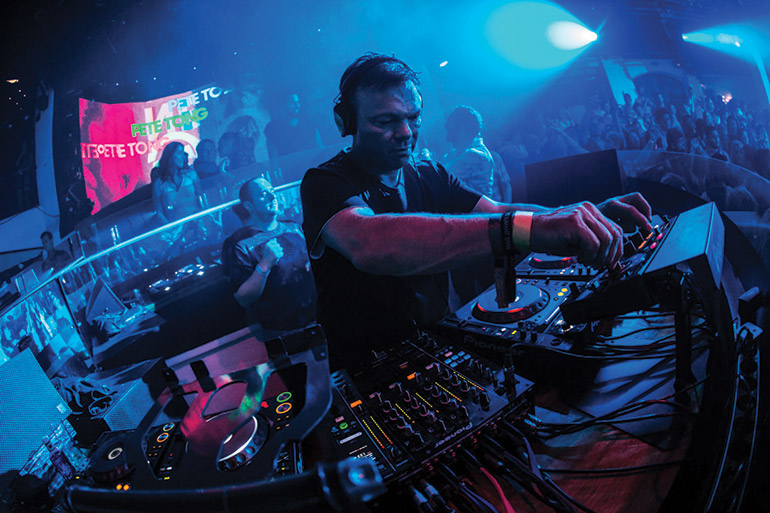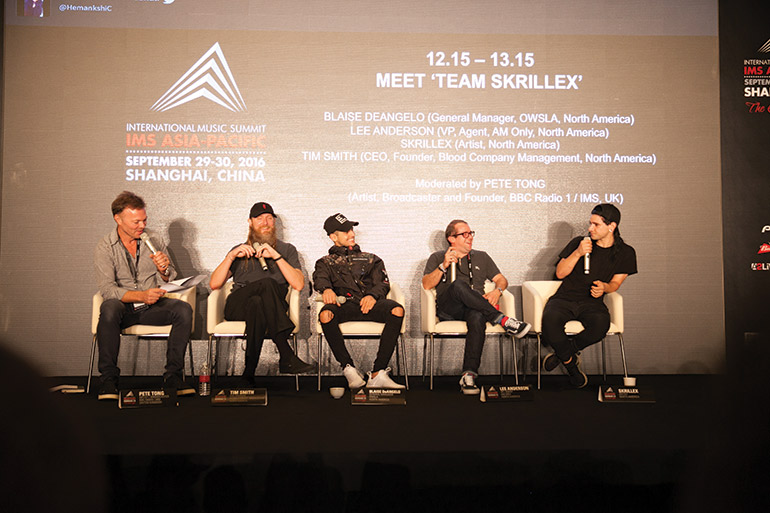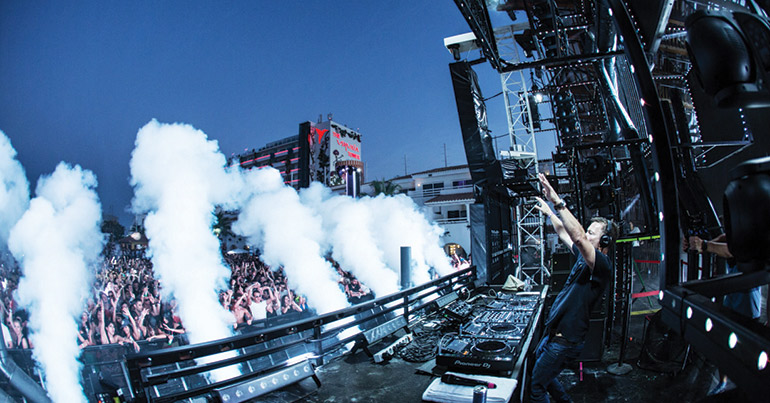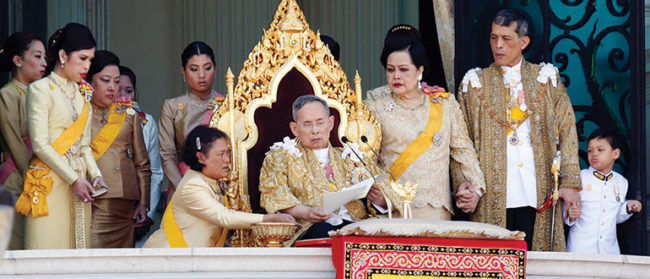
Cockney rhyming slang is a peculiar dialect. Said to have originated in east London in the early 19th century, talk of “going down the battle cruiser” and then “popping for a quick Ruby Murray” has baffled many non-natives for centuries. A constantly evolving vernacular, new phrases are common and often rooted in the pop cultural zeitgeist of the day. A couple of decades ago, this dubious honour was bestowed upon a DJ for the first, and only, time.
“It’s all gone Pete Tong” passed into common parlance in the mid-1990s, and the man himself says that upon first hearing the phrase: “I laughed. My mum didn’t get the joke, but I was flattered.”
Whatever his feelings on becoming enshrined in rhyming slang for all eternity, it demonstrates just how prominent Pete Tong had become in the dance music scene and the wider public consciousness. Despite the phrase meaning that things have gone awry (Pete Tong = wrong), for this DJ from the unremarkable British town of Dartford, things were going very, very right.
“I transitioned from a drummer at school to a DJ playing weddings and school discos when I was 16,” he remembers. “I fell in with a cool crowd who were going to London clubs, and eventually started my own residency at the Hilltop [a club in Tong’s home county of Kent] on a Monday night… People travelled for miles to come to that night, and I met a lot of great people. It was my gateway into the London scene.”
Dance music exploded in the UK in the late 1980s, and the scene’s fusion of fast beats with fast times was also taking hold across Europe. But it was the 1990s when the DJs themselves truly came to the fore. This was the era of the ‘superstar DJ’,
a time when the humble disc jockey could enjoy the fruits of the fabled ‘rock star lifestyle’ – a glamorous, jet-setting world of godlike hero worship, enormous crowds and even bigger pay cheques.
Tong was, and still is, one of the most famous DJs in the world, though his role has evolved over time. He now finds himself in the curious position of being a working musician who can still pack in the crowds, but also a respected elder statesman, almost a patron of the dance music arts.
This status can be partly attributed to his long-running show on BBC Radio 1, the Essential Selection, which has enjoyed a prime time slot for 25 years, attracts millions of listeners and is widely regarded as one of the world’s most important dance music showcases.
I don’t see why artists from Asia can’t be making an impact around the rest of the world
“[The] Essential Selection has helped literally hundreds of dance acts to further their careers via plays on national radio… [Tong] is a global ambassador for electronic music,” wrote the respected DJ Mag.
The term “global ambassador” has never been more apt for Tong. He recently relocated to Los Angeles, where he is helping stoke dance music’s staggering growth in the US, and is the founder of the International Music Summit (IMS), a conference that might be described as the TED Talk of dance music.
After the first IMS was staged in Ibiza in 2008, there are now three summits annually, across three continents, with this year’s incarnations taking place in LA, Ibiza and Shanghai. On 29-30 September, IMS Asia-Pacific brought together industry moguls, the world’s biggest DJs (such as Skrillex, Alesso and Tong himself), and local talent such as Nakadia, a popular Thai DJ who has performed in more than 60 countries.
“[The IMS is] a place where authoritative voices gather to talk about… the challenges faced by the world of electronic music and the wider business,” Tong says. “We started looking at Asia, the whole region, a few years ago. I think probably because it was the new frontier. [In many places] everyone listens to the same music, dances to the same DJs and buys from the same brands. If there’s the one place in the world where that’s still a little different, apart from Central Africa, it’s Asia. Asia’s still a bit of an unknown to the rest of the world.”

While the surging popularity of dance music in Southeast Asia is linked inextricably to its rise as EDM (electronic dance music) in the US, where artists such as Skrillex, Deadmau5 and Diplo have brought it into the mainstream, the genre does have deeper roots in the region. Zouk nightclub in Singapore, opened in 1991 by Lincoln Cheng, is credited by many with bringing dance music to this part of the world. It has since hosted every pre-eminent DJ from Carl Cox to the Chemical Brothers, and was ranked number six on DJ Mag’s Top 100 Clubs list for 2016, widely seen as the worldwide industry authority. The region’s other entries on the list are Zouk KL at number 26, Valkyrie in Manila at number 61, and Jakarta clubs Dragonfly and X2 at 78 and 97, respectively.
“Obviously, a lot went on in Bali back in the day; then it seemed to go backwards a little bit… A lot of us leading DJs had been all over the Asia-Pacific region numerous times and still go: ‘Can it go to another level?’” says Tong of Asia’s clubbing scene. “I’m particularly pleased to see that there’s definitely more of an appetite now for dance music other than the lowest common denominator, other than the most commercial end of it. I saw that the last time I was playing there, just earlier this year, and I found a really great appetite for the underground in Bali and in Hong Kong and in Thailand.”
Tong voices an affinity with Bali on more than one occasion, saying he has had “so many amazing gigs” there and describing it as “definitely the place in the region that is closest to the spirit of Ibiza”. That tiny Spanish island has been the heartland of dance music for 30 years, but the rest of the world is catching up, with world-class clubs popping up in cities from Asunción to Sofia. His patchwork of passport stamps has never been more diverse, but Tong says – rather believably – that Asia moves him the most.
“When you first start to tour the world, everything is completely nuts, everything’s a novelty, everything’s fresh, everything’s new,” he says. “And then suddenly everything becomes very normal and slightly tedious and we all sound like spoilt brats, moaning about this amazing journey that we get to go on. But I think that [Asia’s] the most thrilling region to visit because there’s still that, you know, just walking through the airport, the communication barrier, everything’s still a lot more foreign and a lot more different.”
The Asia-Pacific region is still very much finding its way in terms of dance music, but one possible boon for the region reaching its potential is that Tong and his contemporaries have, to an extent, done this before.
In the 1990s, Tong and European dance heavyweights such as Tiesto and Paul Oakenfold were in and out of the US regularly, creating ripples, but those ripples died when they departed. Tong says the US experience has shown that the key to getting things off the ground in Southeast Asia will be the emergence of a genuine local scene.
“Nothing ever happens unless you can get into a rhythm and keep going back repeatedly – weekly, monthly, annually, to build a culture, and to build your own local success stories as well,” he says. “If the scene just derives around when you’re lucky enough to book Alesso or Calvin Harris or Diplo, and then when they leave nothing happens locally in between, you don’t get stickiness.
“That’s the biggest challenge for all of the promoters and operators in the region. This year I went to Vietnam for the first time and played in Saigon. I just played to 500 people in a little room that was almost like [legendary Ibiza bar] Café Mambo. It felt like there was a real sense of community; it was really exciting and probably my favourite gig of the tour, because it felt like the most ‘new frontier’ gig of them all. But the challenge for that guy is when I’m gone can he keep that going? Can he do a weekly night? Can he do a monthly night? What can he build when I’m not there? That’s what’s going to change things.”
Despite a pronouncement at IMS Asia-Pacific by David Levy, a famed dance music agent and partner with WME, a major US talent agency, that: “This could potentially be the biggest market in the world. It’s that simple,” there does seem to be a key ingredient missing from Tong’s recipe for dance music success. With a few notable exceptions, such as Nakadia and Celeste Siam, relatively small numbers of local DJ talent have been able to make the transition to the big time.
“I’m not feeling a lot of local talent, but I think that’s largely to do with ignorance,” says Tong. “We do need to be made more aware of what’s going on in this part of the world – something that we can hopefully promote further at the IMS… You know, it’s a bit easier to find the next Skrillex in China than it would be in America right now, where there’s a million eyeballs looking for the hot new thing. I don’t see why artists from Asia can’t be making an impact around the rest of the world… That’s definitely something to explore, and I’m definitely an advocate.”


